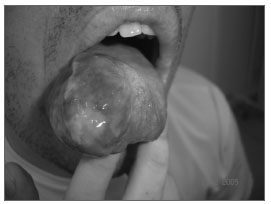

Year: 2012 Vol. 78 Ed. 2 - (24º)
Relato de Caso
Pages: 136 to 136
Hemangiopericytoma of the tongue
Author(s): Carlos Eduardo Molinari Nardi1; Victor Bandini Vieira2; Elio Gilberto Pfuetzenreiter Jr.3; Rogério Aparecido Dedivitis4
Keywords: hemangiopericytoma, immunohistochemistry, tongue neoplasms.
![]()
INTRODUCTION
Hemangiopericytoma is a rare type of tumor, which was first described in 1942 by Stout & Murray1,2. It is believed that the hemangiopericytoma stems from vascular cells called Zimmerman pericytes. These pericytes are found throughout the entire spiral body which involves the capillars and post-capillary venules3. There is a predilection for the muscle-skeletal system4. It represents about 1% of all the vascular tumors2, and it usually affects adults4. Clinically, it affects any age, having a greater incidence between the third and sixth decades of life, without any gender predilection. It usually courses with slow and painless growth2. We describe here the case of 34-year-old patient with this tumor in the oral cavity.
CASE REPORT
A 34-year old male patient with a lesion on the right tongue border, with two months of onset, with slow and progressive growth (Figure 1). He had been previously treated with cephalexin in another clinic, for seven days, without improvement. We chose the excisional biopsy and completely resected the lesion, which was well outlined upon surgery. The microscopic exam showed an amorphous mass, of gelatinous consistence, white-opaque color, with dark brown areas. The microscopic exam showed an ulcerated nodular structure made up of spindle-like cells arranged in bundles with uniform nuclei and low mitotic activity. There were areas with blood vessel proliferation. Immunohistochemistry showed a positive reaction towards the following markers: CD34, actin and factor VIII, yielding the diagnosis of hemangiopericytoma. The macro and microscopic margins were free, reason why no adjuvant therapy was required. The patient did not show evidence of disease after 18 months of follow up.
Figure 1. Tumoral mass in the right-side tongue border.
DISCUSSION
The hemangiopericytoma is uncommon in the head and neck2. Stout & Murray (1942) described 691 cases of vascular tumors, and only nine of them were hemangiopericytomas1. Since then, there are approximately 300 cases of hemangiopericytomas described, especially on the trunk and lower limbs2. Only 15% to 30% of these tumors are found in the head and neck3. At this location, it affects mainly the soft tissue surrounding the oral cavity, sinusal tract and meninges and, more rarely, the orbit, parotid gland, skull base and temporal bone2.
Angiographic characteristics may help differentiate hemangiopericytomas from other types of hypervascularized tumors. Image studies, such as radiographies, CT scans and angiography are not specific. MRI reveals a solid mass with isodense contrast in T12. Enzinger reported the following characteristics which match a high grade tumor: nuclear atypia, necrosis, hemangioma, four mitosis per microscopic field, and size greater than 6.5 cm2.
The differential diagnosis of highly vascularized tumors in the head and neck is a challenge, especially because of the difficulty in differentiating hemangiopericytomas from other tumors which have a prominent vascularization2. The differentiation of the hemangiopericytoma with the solitary fibrous tissue is complicated because of its marked morphology and similar immunohistochemistry. Positiveness for antigens CD-99 and bCl-2 is similar to that of solitary fibrous tumor; nonetheless, CD-34 varies its reaction and is not inconstantly positive for hemangiopericytoma5.
The treatment of choice is complete surgical resection of the lesion. Adjuvant radiotherapy and chemotherapy may be indicated in cases in which there is only a partial resection2.
Recurrences and distant metastases are rare in patients treated with complete surgical excision; nonetheless, most of the patients who had metastases or recurrences were diagnosed after over 40 months of follow up; suggesting a long standing postoperative follow-up for all the patients3.
REFERENCES
1. Stout AP, Murray MR. Hemangiopericytoma: a vascular tumor featuring Zimmermann's pericytes. Ann Surg. 1942;116(1):26-33.
2. Carvalho JR, Haddad L, Leonhardt FD, Filho MFM, Santos RO, Cervantes O, et al. Hemangiopericitoma maligno de cabeça e pescoço em uma criança: relato de caso. São Paulo Med J. 2004;122(5):223-6.
3. Prado FAP, Romano FR, Voegels RL, Butugan O. Hemangiopericitoma de seio esfenoidal. Arq Otorrinolaringol. 2004;8(3):284-8.
4. Alabdulhadi K, Burezq H, Nguyen VH, Bernard C, Manoukian JJ. Extensive tongue hemangiopericytoma in a child: modified combined modality of treatment to preserve well functioning tongue. Int J Pediatr Otorhinolaryngol. 2004;68(2):211-9.
5. Alawi F, Stratton D, Freedman PD. Solitary fibrous tumor of the oral soft tissues. Am J Surg Pathol. 2001;25(7):900-10.
1. Head and Neck Surgery Resident - Hospital Ana Costa, Santos/SP, Brazil.
2. Medical Student - Universidade Metropolitana de Santos.
3. MSc in Health Sciences - Graduate Program of the Hospital Heliópolis HOSPHEL, São Paulo/SP. Professor of Surgery - Fundação Lusíada UNILUS, Santos/SP. Assistant- Head and Neck Surgery Services - Hospital Ana Costa and at the Irmandade da Santa Casa da Misericórdia de Santos.
4. MD. Senior Associate Professor - Fundação Lusíada UNILUS.
Serviço de Cirurgia de Cabeça e Pesoço do Hospital Ana Costa, Santos/SP, Brasil.
Send correspondence to:
Rogério A. Dedivitis
Rua Olinto Rodrigues Dantas, 343 conjunto 92
Santos - SP. CEP: 11050-220
E-mail: dedivitis.hns@uol.com.br
Paper submitted to the BJORL-SGP (Publishing Management System - Brazilian Journal of Otorhinolaryngology) on January 09, 2011.
And accepted on March 10, 2011. Cod. 7505.
All rights reserved - 1933 /
2025
© - Associação Brasileira de Otorrinolaringologia e Cirurgia Cérvico Facial
